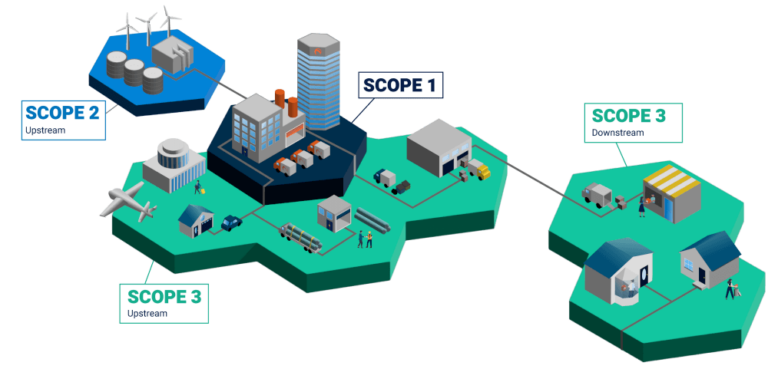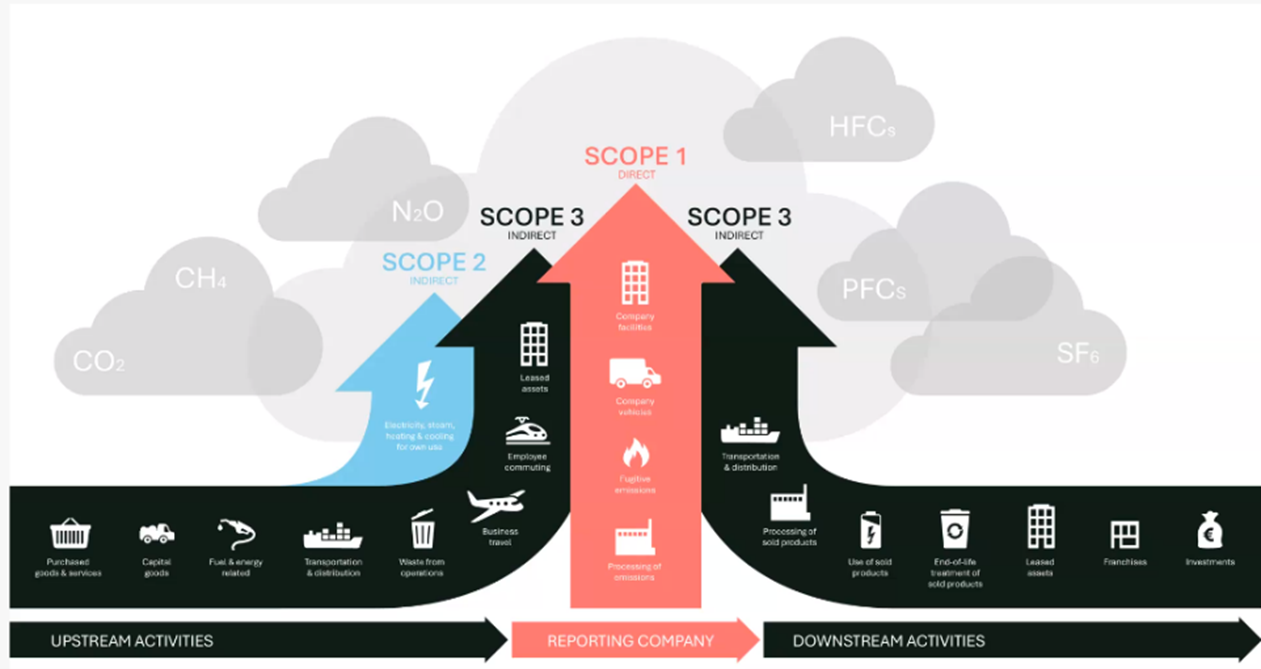Home – Solutions – Net Zero & Decarbonisation – What are Scope 1, 2 and 3 Emissions?
Contents
- Scope 1 2 3 Emissions Explained
- What are Scope 1, 2 and 3 emissions?
- Scope 1, 2 & 3 definitions
- Scope 3 Definition
- Upstream and downstream emissions
- Why measure all three scopes?
- How Anthesis Can Help
- Contact Us
Share this guide
Scope Emissions Explained
At the heart of the decarbonisation effort to combat climate change is the need to efficiently measure and track greenhouse gas (GHG) emissions. As companies, public bodies, and consumers continue to align with the global sustainable development agenda, it has become essential to ensure that carbon and GHG reduction strategies are in place, which first requires an understanding of those emissions.
For many organisations, gaining an understanding of their GHG footprint is a precursor to being able to set ambitious reduction targets, design and deliver effective climate solutions. Without this vital piece of information, planning and executing strategies to effectively reduce carbon emissions are likely to be wrought with problems. To combat this and further formulate a standardised approach to GHG reporting, emissions can be classified into three distinct ‘scopes’, as defined by the GHG Protocol Corporate Standard, which covers both direct and indirect emissions related to a given organisation.

Reducing carbon emissions has become a business imperative
Want to find out how you can reduce your carbon emissions?
What are Scope 1, 2 and 3 emissions?
The GHG Protocol has defined three scopes of emissions to categorise the different kinds of emissions a company or organisation creates. The scopes correlate to who ‘owns’ those emissions and the level of control applicable to changing those emission levels at each stage. Scope 1 are direct emissions that are owned or controlled by a company, whereas scope 2 and 3 are indirect emissions that are consequences of the activities of the company, but occur from sources not owned or controlled by it.
Scope 1 and 2 emissions are a mandatory part of reporting for many organisations across the world, while Scope 3 emissions are mostly voluntary to report.
Scope 1 emissions are emissions made by a company directly, that are owned or controlled by the company.
Scope 1 emissions examples
- Building onsite energy use (e.g., space heating)
- Building refrigerants
- Company Vehicles Fuel consumed by owned and leased vehicles
Scope 2 emissions are those emissions the company makes indirectly, such as by buying energy.
Scope 2 emissions examples
- Purchased electricity, steam, heating & cooling for own use
Scope 1, 2 & 3 definitions
| Scope | Emission Type | Definition |
| Scope 1 | Direction Emissions | GHG emissions directly from operations that are owned or controlled by the reporting company |
| Scope 2 | Indirect Emissions | Indirect GHG emissions from the generation of purchased or acquired electricity, steam, heating, or cooling consumed by the reporting company |
| Scope 3 | Indirect Emissions | All indirect emissions (not included in scope 2) that occur in the value chain of the reporting company, including both upstream and downstream emissions |
Scope 3 emissions definition
Scope 3 emissions are centred on emission sources that are more external to a specific organisation, such as those across the supply chain. Scope 3 emissions remain mostly voluntary to report, however, in most cases the reduction of Scope 3 has the potential to have the largest impact. Scope 3 emissions are often the most difficult to measure, track and report.
Scope 3 examples
- Purchased Goods and Services
- Capital goods
- Upstream and Downstream Transportation & Distribution
- Business Travel (incl. Remote Working)
- Employee Commuting
- Leased Assets
- Waste Generated in Operations
- Investments
What are upstream and downstream emissions?
Upstream and downstream scope emissions refer to distinct phases in the lifecycle of a product or process where greenhouse gas emissions are generated, either directly or indirectly. These terms are often used in the context of assessing the environmental impact of activities.
Upstream Scope Emissions
Upstream scope emissions encompass the environmental impacts associated with the extraction, production, and transportation of raw materials, components, and energy sources required for a product or process. These emissions occur prior to the final manufacturing or operation stage. Upstream emissions include factors such as resource extraction, manufacturing of components, and transportation of materials to the production site. They are essentially the “pre-production” emissions that contribute to the overall carbon footprint of a product or process.
Upstream scope examples
- Purchased electricity, steam, heating & cooling
- Purchased goods and services
- Captial goods
- Transportation of materials to production site
- Waste
- Business travel emissions, such as air travel, rail, underground, taxi, and bus
- Employee commuting emissions
Downstream Scope Emissions
Downstream scope emissions encompass the environmental impacts that occur after the product has been manufactured or the process has taken place. These emissions are associated with the distribution, use, maintenance, and disposal of the product. Downstream emissions may include factors such as transportation to end-users, energy consumption during product use, and the eventual disposal or recycling of the product at the end of its lifecycle. These emissions contribute to the overall environmental impact beyond the initial production phase.
Downstream scope examples
- Transportation and distribution to end-users
- Energy consumption during the processing of sold products
- Energy consumption during the use of sold products
- Disposal or recycling at the end of the product’s lifecycle
- Franchises emissions
- Investment emissions
In essence, the difference between upstream and downstream scope emissions lies in the timing and nature of the emissions. Upstream emissions are tied to the early stages of production and supply chain activities, while downstream emissions occur during the later stages, encompassing product usage, distribution, and end-of-life processes. A comprehensive understanding of both upstream and downstream emissions is crucial for a holistic assessment of a product or process’s environmental footprint.

Why should you measure all three Scope emissions?
While many organisations have ramped up their efforts to report on their carbon and energy emissions, there will continue to be an increase in the requirements associated with managing and auditing emissions through schemes such as TCFD and SECR. Reporting on Scope 1 and 2 is mandatory for many, whilst reporting emissions across the whole value chain will increasingly become harder to avoid.
Organisational power to change
The control an organisation has over its emissions should not start and stop at its front door. Utilising the power to influence behaviours throughout the value chain will be instrumental in reporting and minimising emissions related to a product or service. Understanding and reporting on emissions now will empower your business and provide a proactive approach to aligning with increasingly mandatory climate regulations.
What are the benefits of reporting your Scope emissions?
Organisations that engage with Scope 1, 2 and 3 reporting can see a myriad of benefits, including:
- Improved transparency, customer trust, brand and reputational enhancement
- Identification of the climate-maturity of key value chain players and the ability to identify value chain hotspots and weaknesses
- Better understanding of exposure to resource, energy and climate-related risks
- Lower energy and resource costs
- Positive engagement with employees and consumers
- Compliance with regulatory GHG reporting requirements
How Anthesis Can Help Reduce Scope 1, 2 and 3 Emissions
Anthesis provides holistic, global solutions for the measuring and reporting of all scope emissions. We support clients to help identify carbon and greenhouse gas emissions across the value chain and strategically plan for a low carbon future. This support includes providing expert guidance and consultative services for legislative compliance, carbon management and assisting routes to carbon neutrality and sustainable energy management.

Measure your GHG emissions
Discover Anthesis RouteZero: Anthesis’ Comprehensive Greenhouse Gas (GHG) Inventory Management solution
Designed from the insights of over 4,000 GHG footprints globally, RouteZero accelerates the pace with which organisations can assess their scope 1, 2 and 3 impact and develop actionable decarbonisation plans.





